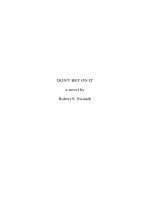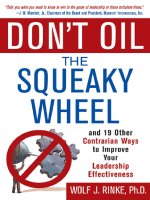Negotiating Trick: Don't Focus on Price
Bạn đang xem bản rút gọn của tài liệu. Xem và tải ngay bản đầy đủ của tài liệu tại đây (61.18 KB, 2 trang )
inc.com
/>Negotiating Trick: Don't Focus on Price
There is one line no salesperson ever wants to hear from a buyer. Make sure you're in the clear.
Jack Flash/Getty
"That's more than I had expected." Have you heard this line?
Of course you have. It's a standard response, heard a gazillion times a year by salespeople
everywhere, after a price is quoted or heard. And quite frankly, it's an understandable response from a
prospective buyer especially one who is not experienced in purchasing your type of product or service.
What actually drives the response?
Lack of context: When the buyer does not understand the problem accurately, he or she
cannot connect the solution's price to its value. Therefore, every number has the potential of being
wrong.
No way to defend it: Often buyers are reacting not to the number itself, but to the presumed
reactions of others to whom they will have to explain or present it.
Knee-jerk negotiating tack: Some people use this as their standard response, regardless of
the number.
Regardless of the reason, if you get to the point of submitting a price quote and you get that response,
then it is possible you missed a couple of key steps earlier in the process.
Surprising prospects is bad. It's bad for them, because it causes them to recoil, but it's also bad for
you, because you may be tempted to make concessions or, worse, discover you wasted your time
altogether.
Better Way to Shape the Conversation
To avoid getting a surprise response, make sure you build these steps into the process.
1. Discuss cost parameters early and often. Even if you have a sophisticated buyer, you need to
frame cost ranges during the discovery process. There are lots of ways to tackle the subject, but one of
my favorite ways to ask is, "What is the range you were expecting to spend on resolving this issue?"
Here's another approach: "Projects like the one we are discussing have come in at a price range
between $XXX and $YYY. Is that what you were expecting?"
2. Understand the value of a 100% assured outcome. Many times, you get the opportunity to
acquire a new client because a competitor has failed. This means that the buyer has paid a price in the
past and failed to achieve the desired outcome. This actually provides a context: the cost of failing. You
now need to determine how the customer would value having confidence in a successful outcome.
3. Help the buyer frame the problem differently. Recently, a client of mine was presenting a training
program for implementing a new enterprise software system. When the price was discussed, the buyer
said, "That's more than the software cost!" The problem was that the buyer saw the decision as
connected to license fees, rather than productivity and utilization.
Do not succumb to the temptation of offering concessions or asking, "How much can you afford?"
Instead, try helping your prospect to see the problem differently and develop greater confidence in the
outcome of purchasing your solution.
Author, speaker and consultant Tom Searcy is the foremost expert in large account sales.
With Hunt Big Sales, he's helped clients land more than $5 billion in new sales. Click to get
Tom's weekly tips, or to learn more about Hunt Big Sales. @tomsearcy
do.bruce92
VIEW MORE COMMENTS









